
 Jeff Sundin Fishing Report September 27, 2017 "October, The New September"
Jeff Sundin Fishing Report September 27, 2017 "October, The New September"
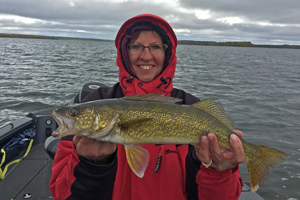 This won't be the first time that folks who've fished with me have heard this, but for everybody else; "October is the new September". At least that's the effect of this unusual weather pattern that we've enjoyed these past few years.
This won't be the first time that folks who've fished with me have heard this, but for everybody else; "October is the new September". At least that's the effect of this unusual weather pattern that we've enjoyed these past few years.
It is irrelevant whether or not you, I or anybody else believes in so-called climate change. But there’s no running away from the fact that we are definitely in some sort of a cycle and that it has changed the way anglers should approach the timing of fall fishing. The once reliable September, has temporarily become a time of transition, rather than the time of ultimate action. The current weather patterns compare to the patterns that formerly occurred during late August and early September.
Surface water temperatures inched downward during an all-day soaking rain on Tuesday. Now hovering at 61.5 degrees, the timing is near for an all-out fall feeding migration to begin. In fact, most fish species are already showing signs of intensified feeding activity. We’ve enjoyed fabulous fishing for Crappies, Perch and Sunfish this week; Walleye activity is increasing, slowly but steadily.
Since Sunday, presentations have been in a state of flux too. We have caught some walleyes using jigs and minnows, some of them using wiggle worms and still others trolling spinners tipped with night crawlers. Because most other fish species have reacted well to jig and minnow fishing, I've become more dependent on this presentation; it has allowed me to keep good action going while we search for walleyes.
For me, surface temperatures between 58 and 60 degrees usually trigger the best Walleye action during the fall. As it approaches 55 degrees and lakes enter the turnover period, it will likely peak, providing the most intense feeding activity.
Historically, the pre-turnover peak for Walleye fishing has happened sometime during the first week of October. Granted, it could still occur anytime within the next couple of weeks, but the weather trend appears to make that unlikely and as it warms again, the turnover will be delayed.
The good news for us Walleye anglers who are still out on the lakes, we have some good days to look forward to. Unfortunately, the best Walleye action will come after the majority of folks have already completed their fall fishing trips and turned their attention to hunting and other pursuits.
As a matter of fact, I’d love to turn my attention toward hunting too, but I’m thinking about opening up one more week of fishing dates. I’ll be taking that decision sometime later today and soon after that, I will send out an “insider newsletter”. If you’re interested, be sure to watch your inbox for the “Early Bird Insider News”. - Jeff Sundin 218-245-9858 or EMAIL Lake of the Woods, LOW Tourism September 26, 2017
Lake of the Woods, LOW Tourism September 26, 2017
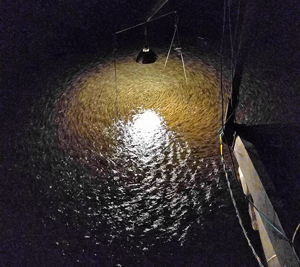 "Lighthouse Gap and along the south shore continues to gain steam and numbers of walleyes. As the shiners push shallow and into the Rainy River the walleyes are hot on their heels. Charter boats are still fishing all parts of the lake such as the main basin of Big Traverse Bay and making the trek to the north part of the lake. Just two miles out in 28-30 feet doing the best. Morris Point Gap doing well in 27 - 30' feet. Anchor up with a jig with a shiner minnow the best tactic. Schools moving around finding bait. Pink and gold have been the hot colors. Still huge schools roaming the main basin of Big Traverse Bay in 31-34' where trolling crankbaits effective. Big walleyes being caught all over.
"Lighthouse Gap and along the south shore continues to gain steam and numbers of walleyes. As the shiners push shallow and into the Rainy River the walleyes are hot on their heels. Charter boats are still fishing all parts of the lake such as the main basin of Big Traverse Bay and making the trek to the north part of the lake. Just two miles out in 28-30 feet doing the best. Morris Point Gap doing well in 27 - 30' feet. Anchor up with a jig with a shiner minnow the best tactic. Schools moving around finding bait. Pink and gold have been the hot colors. Still huge schools roaming the main basin of Big Traverse Bay in 31-34' where trolling crankbaits effective. Big walleyes being caught all over.
Rainy River anglers finding gallons of shiners and the walleyes are in the river with morning/evening still the best. Trolling cranks or vertical jigging tipped with a shiner doing good. Smallmouth bass and crappies showing up as well. Many sturgeon of all sizes being caught with some over 50" and 60" being boated at all times of the day and night in the deep holes.
Up at the Northwest Angle, in MN waters, bottom bouncing or trolling with cranks to cover a larger area then changing over to jigging with pink, white or gold producing fat walleyes who are chasing bait fish and have the feed bags on. Current areas between the islands producing and holding fish in 10-24 ft. When you find the bait the walleyes will be near by. Canada crappie fishing is on fire in deeper holes off of protruding points. Muskies being caught on jerk baits and blade baits. Traditional shallow, wind-blown rocks with access to deep water nearby have been the most productive spots while the water temperature continues to drop." – Lake of the Woods Tourism, (800) 382-FISH
![]() Lake of the Woods, Border View Lodge September 26, 2017
Lake of the Woods, Border View Lodge September 26, 2017
"September is cruising by. We are seeing the Shiner Minnow traffic increase just off of our docks. Things are cooling down and we have had some rain the past week. Waterfowl and Grouse Hunting have started and there are still many having great success with Goose Hunting.
We are still having great success catching Walleye on the South shore of Big Traverse. Again, this past week, the weather has created some days where fishing the North side of the lake was the best option.
We are showing more rain for the week ahead with highs into the 60’s and lows in the 40’s.
Our winter rates are published on our website, book early to get the best dates. Here is a great deal on Sleeper Houses for this coming winter. Make your Sleeper House reservation for a Mid-week stay by November 30th and get 10% off." - 1-800-776-3474 Border View Lodge .
 Jeff Sundin Fishing Report September 25, 2017 "Summer Extension For Minnesota Anglers"
Jeff Sundin Fishing Report September 25, 2017 "Summer Extension For Minnesota Anglers"
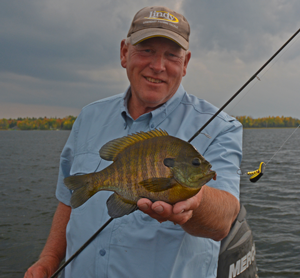 Welcome to fall in Minnesota, where the scenic beauty of fall colors can be viewed wearing swimsuits during a mid-July like heat wave.
Welcome to fall in Minnesota, where the scenic beauty of fall colors can be viewed wearing swimsuits during a mid-July like heat wave.
Alright, around the country, most folks probably don’t think that 80 degrees is all that hot, but here, especially for me, it is and especially if the date is September 24th!
Fishing through the duration of this odd weather pattern has been surprisingly good, as long as you’re not trying to catch Walleyes. Over the past week, I along with my various fishing crews have enjoyed phenomenal Pike fishing, colossal Crappie fishing, prodigious Perch fishing and as of yesterday, sensational Sunfishing.
With all of that action going on, it’s unclear whether I can’t find a hot bite for Walleyes, or if I’ve just been so distracted by all of the opportunity, that I’m not searching all that hard for them. And it’s not like we can’t catch any, we do, but we’re catching them in small numbers and at random times.
Surface water temperatures, depending on which lake we’re fishing, range between 62 and 65 degrees. Those temperatures are approaching the ideal range to trigger a good fall walleye bite. The immediate problem for walleye fishermen is that we haven’t had a cold enough cold snap to force bait and small fish out of the weeds. The shallow weed beds that contain submerged vegetation like Cabbage, Coontail and Eelgrass remain green and lush. These shallow weedy flats are teaming with life and it’s not speculation, we can see the fish churning and swirling all over the surface; to them, this is still mid-summer.
I haven’t talked about mixed bag fishing along the weedlines for weeks, but on Sunday the tried and true system was back in vogue, producing fast action for Sunfish, Bass and Pike.
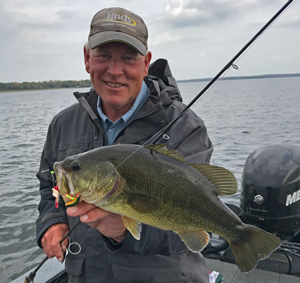 The one notable departure from a typical mid-summer experience was that fish showed a strong preference for either Cabbage or Eelgrass. There were a few fish holding in and around Coontail patches, but the dense weeds were much more sparsely populated. On the surface, that may sound like a small detail, but when we fished one shoreline that hosted the preferred vegetation; the action was fast and furious. Conversely, another shoreline on the same lake that was home to the “wrong” vegetation produced gloomy results. If we’d only fished there, we’d have proclaimed this lake to be like the Dead Sea.
The one notable departure from a typical mid-summer experience was that fish showed a strong preference for either Cabbage or Eelgrass. There were a few fish holding in and around Coontail patches, but the dense weeds were much more sparsely populated. On the surface, that may sound like a small detail, but when we fished one shoreline that hosted the preferred vegetation; the action was fast and furious. Conversely, another shoreline on the same lake that was home to the “wrong” vegetation produced gloomy results. If we’d only fished there, we’d have proclaimed this lake to be like the Dead Sea.
Like the summertime mixed bag pattern you’ve seen before, we trolled the weed edges. But another departure from a typical mid-summer experience was that faster moving spinners were less productive than baits that we could troll at slightly slower speeds. Instead of zipping through at 1.3 MPH using Little Joes, we slowed down to .8 to .9 MPH and used Lindy’s Lil’ Guy tipped with a night crawler to produce more strikes.
Sunfish definitely preferred live worms, when I did an experiment using pork rinds, Largemouth Bass were ecstatic about that combination. Bass of all sizes struck the bait, including some very healthy examples. Sunfish struck the artificial bait too, but not as often and now with the same vigor. To help cut the consumption of our bait supply; I clipped off the back hook. Fishing the Lil’ Guys as a single hook bait using 1/3 of a night crawler worked like a charm.
One final notation about Walleye fishing is that wind appears important in determining whether they will be active or not. Twice this week, I’ve returned to lakes where we caught Walleyes one day, but could not find them again on the next. Both of those trips occurred when one day was breezy, but the next one was calm.
Interestingly, the walleyes were the only fish affected by the calm waters. Crappies, Perch and Northern Pike continued to be active whether the water was choppy of calm.
Walleye purists may be discouraged by both the tardiness and the inconsistency of the “fall walleye run”. But if you share my point of view, fishing is good right now. There’s a lot of variety out there, the action has been very good and finding delicious fish for a meal is easy work.
 Wired2Fish "Fizzing Bass: Are You Doing More Harm Than Good?"
Wired2Fish "Fizzing Bass: Are You Doing More Harm Than Good?"
 Professional Fisheries Biologist Steven Bardin explains a common problem that could be hurting fish after they’re released.
Professional Fisheries Biologist Steven Bardin explains a common problem that could be hurting fish after they’re released.
You often hear about venting, or “fizzing” bass—especially in the summer and winter months when they’re caught from deep water. While it’s performed with the very best of intentions, there’s a common mistake anglers make that could be harming the bass once they’re released back into the water.
When an angler catches a fish from deep water and reels it through the water column quickly, barotrauma can occur. According to Bardin, this is simply a quick change in pressure on the ..." Read >> Fizzing Bass: Are You Doing More Harm Than Good? Planning
 Jeff Sundin Fishing Report September 22, 2017 "Saying Goodbye To Summer?"
Jeff Sundin Fishing Report September 22, 2017 "Saying Goodbye To Summer?"
 The Autumnal Equinox, according to the calendar is today. That means supposedly summer is over and fall is here to stay.
The Autumnal Equinox, according to the calendar is today. That means supposedly summer is over and fall is here to stay.
The lakes must have separation issues though because as near as I can tell, they are doing everything in their power not to let go of summer, or summer fishing patterns.
On Thursday, I ventured west of town with my crew, Kyle and Karen Reynolds to visit one of the areas smaller “mixed bag” lakes.
Similar in nature to many of the Itasca area multi-species waters, this one has a maximum depth of less than 40 feet, a moderate amount of shallow water cover and a diverse mixture of weeds. There are Walleye, Perch and Pike in the lake, along with a smattering of Panfish and some Largemouth Bass; it was reasonable to expect that we’d catch something.
On the surface, water temperatures were 65.4 degrees and remained uniform all day. There was a fairly stiff breeze from the southeast that churned up a good chop on the water.
It didn’t take long to discover that perch were very active and soon became the focal point of our fishing trip. Walleye struck too, but it’s hard to say how active they actually were because we didn’t spend much time specifically targeting walleye. Pike were somewhat active too, and came along at irregular intervals as we fished for Perch. We bagged 4 of the better pike and had some half dozen jigs snipped off our lines. We never targeted them; so virtually all of them were incidental catches.
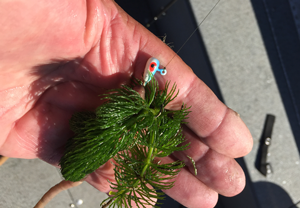 We bagged 6 Walleyes, 4 of them caught on purpose and 2 of them struck while we were catching Perch. Of the 4 that we caught intentionally, 3 were bagged using wiggle worms on the weed edges and 1 was caught on a jig and minnow. So apparently, the trend for best walleye production seems to be wiggle worming the weed edges. On the other hand, the incidental walleyes struck jigs tipped with minnows, so it’s fair to say that you will have at least some action using minnows too.
We bagged 6 Walleyes, 4 of them caught on purpose and 2 of them struck while we were catching Perch. Of the 4 that we caught intentionally, 3 were bagged using wiggle worms on the weed edges and 1 was caught on a jig and minnow. So apparently, the trend for best walleye production seems to be wiggle worming the weed edges. On the other hand, the incidental walleyes struck jigs tipped with minnows, so it’s fair to say that you will have at least some action using minnows too.
One of the reasons we didn’t spend a lot of time pursuing walleyes was because they were holding tight to the weed edges. In the strong wind, it was very difficult for my crew to avoid snagging, tugging, pulling and ripping through the dense vegetation.
Judging by the extremely good health of the weeds, it will be a while before fish are forced to move out onto the adjacent breaklines that are easier to fish.
After 3 days of windy but nice weather, it appears that the Reynolds’ are going to put on their rain gear today. It’s storming outside my window this morning and it looks like wet weather will stick around for at least this morning.
All things considered it has been a very good trip for them; we’ve bagged Crappies, Perch and Pike in good numbers. Walleyes have entered the mix, but we’ve been distracted by the others, so today is sort of a walleye-or-die mission. Hopefully, I won’t end this day wondering why I waited until the stormy weather began before I started this little project? I guess we’ll need a bit of good luck. - Jeff Sundin 218-245-9858 or EMAIL
 Lake of the Woods, LOW Tourism September 20, 2017
Lake of the Woods, LOW Tourism September 20, 2017
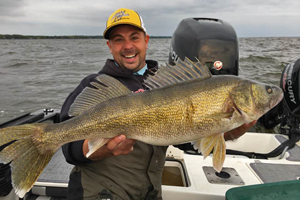 "There has been great walleye action right outside the Lighthouse Gap and along the south shore in anywhere from 11-17 feet of water. Charter boats have still been fishing all parts of the lake. A few miles out of the Lighthouse Gap and in front of Morris Point Gap doing well in 27 - 30' feet. Anchor and a jig with a shiner minnow has been the ticket. Schools moving around. Pink and gold have been the hot colors. Still huge schools roaming the main basin of Big Traverse Bay in 31-34' with trolling crankbaits effective. Some trophy walleyes being caught.
"There has been great walleye action right outside the Lighthouse Gap and along the south shore in anywhere from 11-17 feet of water. Charter boats have still been fishing all parts of the lake. A few miles out of the Lighthouse Gap and in front of Morris Point Gap doing well in 27 - 30' feet. Anchor and a jig with a shiner minnow has been the ticket. Schools moving around. Pink and gold have been the hot colors. Still huge schools roaming the main basin of Big Traverse Bay in 31-34' with trolling crankbaits effective. Some trophy walleyes being caught.
Rainy River anglers finding more shiners and walleyes have entered the river with morning/evening still the best for now. Trolling cranks or pulling spinners producing the best to cover lots of area but walleyes found vertical jigging tipped with a shiner doing good. Smallmouth bass in good numbers along shoreline rock, bridge embankments and feeder streams. Many sturgeon over 50" and 60" being boated at all times of the day and night.
 Lake of the Woods, Border View Lodge September 20, 2017
Lake of the Woods, Border View Lodge September 20, 2017
"The MTT wrapped up another successful year! We finally had some rain, 3 inches in one day was not preferred, but we needed it. Overall this past week was cooler and a sure sign fall is coming. The leaves are starting to turn, with some already a bright yellow. Or as any angler would say it, chartreuse. The large Walleye are eating well and putting on weight, this past week we have caught many large fish some 27 inches long and in the 10-pound range. That is not your typical 27-inch weight of a Walleye on Lake of the Woods.
There has been great Walleye action right outside the Lighthouse Gap this past week. The Rainy River is also getting more Walleye coming in. Our Guides have still been fishing all parts of the lake, most days have been spent a few miles out of the gap and only going further due to wind and weather. Anchor and a jig with a Shiner minnow has been the trick. Pink and gold have been the hot colors, the Tom’s Tackle Strobe Jigs definitely give anglers an advantage.
It appears we will stay cooler this week with possible highs of 70 and lows in the lower 40’s.
Our winter rates are published on our website, book early to get the best dates. Here is a great deal on Sleeper Houses for this coming winter. Make your Sleeper House reservation for a Mid-week stay by November 30th and get 10% off." - 1-800-776-3474 Border View Lodge .
 Jeff Sundin Fishing Report September 20, 2017 - “Happy Birthday Little Brother!”
Jeff Sundin Fishing Report September 20, 2017 - “Happy Birthday Little Brother!”
If you’re lucky enough to have a brother who is kind, thoughtful, caring, warm and generous, then you’re almost as lucky as I AM! That’s because mine is all of these things and much more!
Today is his birthday and I hope you’ll do me a favor and join me in wishing Gary Sundin happy day, filled with love and warmth; he deserves it!
OH, and by the way, I hate to break the news, but he’s moving closer to me in age all the time. On September 20, 1959 I was 250% older than he was; today I am only 102.5% older. Holy Mackerel, that gap is narrowing fast!
Happy Birthday Little Brother, I ‘m thankful for you and everything you do!
 Jeff Sundin Fishing Report September 19, 2017 - “Falling Back To Summertime Presentations”
Jeff Sundin Fishing Report September 19, 2017 - “Falling Back To Summertime Presentations”
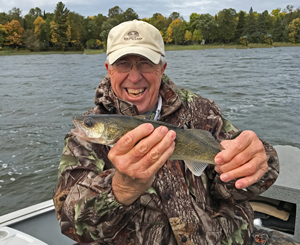 Surface temperatures are falling, now ranging between 61 and 64 degrees and there’s no doubt that cooler water temperatures are triggering some early migrations. Some fish are moving toward fall feeding locations and fall fishing presentations are becoming more reliable each day.
Surface temperatures are falling, now ranging between 61 and 64 degrees and there’s no doubt that cooler water temperatures are triggering some early migrations. Some fish are moving toward fall feeding locations and fall fishing presentations are becoming more reliable each day.
But don’t get too far ahead of the schedule; there are plenty of fish still clinging to late summer patterns.
Last week I wrote about catching Crappies and Northern Pike in shallow weeds. I mentioned too that there were lots of fish swirling and flopping around in weed cover that was literally too thick to fish. The best we could do was to pitch jigs along the weedline to fish that held tight to the transition between shallow weeds and the clean break along the outermost edges.
It was fun horsing those Crappies out of the veggie patch, but guess what? On Monday, the breeze was heavy, the sky was grey and many of those fish that we couldn’t reach before came out to the weed edges to play.
This weed pattern is a classic during late summer, but usually fizzles out whenever the weeds begin to die off. Right now, many of the weed beds we encounter are green, thick and anything but dying off and this reminded me about something I mentioned earlier this summer; seasonal progressions are behind schedule.
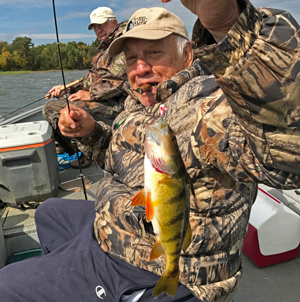 The cycle started off behind schedule last spring, water temperatures were slow to warm and fish were painfully slow to move into historically predictable locations. Throughout early summer, temperatures remained cool and fishing patterns remained behind schedule. Some of the best “June” fishing occurred during July and early August.
The cycle started off behind schedule last spring, water temperatures were slow to warm and fish were painfully slow to move into historically predictable locations. Throughout early summer, temperatures remained cool and fishing patterns remained behind schedule. Some of the best “June” fishing occurred during July and early August.
Even now, our fishing season is behind schedule, the colorful trees hint at the arrival of fall, but the fish say “no, this is still late summer and if you want to find us, you’re gonna have to think about where we should have been back in mid-August”.
For us, this day provided proof; it was a classic, late summer mixed bag of fish. Crappies, Pike, Perch, Walleye and even a few Largemouth Bass were all striking our jigs in the same weed patch. We never knew what would come popping out on the next cast.
By now you might be tempted to think that it was a super-hot-bite, but it wasn’t. It was steady action though and with all of the variety, we were able to bag a few meals each of Crappie, Walleye and Perch. By themselves, no one species would have made this a great trip, but all of them together added up to make it a fabulous day.
I can’t say that I know the “best” presentation because we only used one. Because of the compact design, the short shank, 1/8 ounce Live Bait Jig tipped with a medium Fathead works very well in the heavy weed cover.
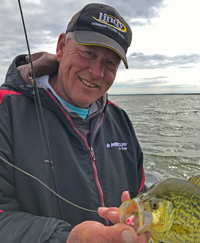 One trick to fishing in and around heavy weeds is to work your lure vertically rather than horizontally. Test the strategy yourself, grab your jigging rod, go outside and cast your jig into the grass. First try retrieving the jig by dragging it through the grass sideways. It stinks doesn’t it? The hook gets snagged on every blade of grass and if you hit a heavy patch, you might get even break your line trying to get it out.
One trick to fishing in and around heavy weeds is to work your lure vertically rather than horizontally. Test the strategy yourself, grab your jigging rod, go outside and cast your jig into the grass. First try retrieving the jig by dragging it through the grass sideways. It stinks doesn’t it? The hook gets snagged on every blade of grass and if you hit a heavy patch, you might get even break your line trying to get it out.
Now try this instead, cast your jig back into the lawn, but use a short hopping motion to lift your jig up and over the grass. Each time it settles back in, you can simply hop it up and over the grass, moving it a foot or two with each hop.
I realize that weeds in the lake can be much thicker than the grass in your back yard. But I think you get the idea, fishing vertically, using short hops to finesse your way through the weeds is a lot more fun than ripping and tugging and getting snagged.
Another tip to remember is not to be too jumpy, just because you feel a tug on your line doesn’t mean that you have to tug back. Every time I hop the jig, I retrieve a little line, as it comes through the weeds, I stop moving it every time I feel anything. If it’s a fish, it will make a move to tip me off, but if it’s a weed there will be nothing but dead weight. When that happens, I let my line go slack to relieve the tension on the hook. That allows the jig to fall way from whatever it’s stuck on and after it falls back, I give the lure one sharp snap upward. Most of the times that will put your lure back into the game, allowing fish another chance to grab it.
Okay, I gotta run, but if you have questions about this presentation, I’d like to help. So if you’ll email me, I promise to answer your questions over the next few days.
 Jeff Sundin Fishing Report September 17, 2017 - “Walleyes, Back To Basics”
Jeff Sundin Fishing Report September 17, 2017 - “Walleyes, Back To Basics”
It’s amazing how fast we can burn through 5 days of fishing! The fall session of “Fun with Dick and Paul 2017” is now entered into the records and like most of the 2017 fishing season, has flown past us more quickly than I’d like.
The weather that Mother Nature dished out over the past couple of days wasn’t exactly comfortable, but we survived. Luckily, our trip ended on a high note this Saturday; almost as if we’d been given a reward for toughing it out during Friday’s stormy and cold weather.
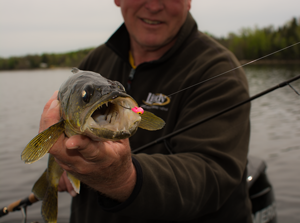 Walleyes on the small lake we fished didn’t run big, but they did run. Because we only wanted a few to finish off the crew's bag limits anyway, catching and releasing a bunch of lesser size fish was preferable to a slower session. Especially considering that we learned on Friday that the quality fish lake may or may not have yielded 3 larger fish.
Walleyes on the small lake we fished didn’t run big, but they did run. Because we only wanted a few to finish off the crew's bag limits anyway, catching and releasing a bunch of lesser size fish was preferable to a slower session. Especially considering that we learned on Friday that the quality fish lake may or may not have yielded 3 larger fish.
As it turned out, we managed to bag 3 between 15 and 17 inches, most of the fish we released ranged in size between 013 and 15 inches. On this day, we only crossed paths with a couple of larger, protected slot-fish.
At 65 degrees, the surface water is just beginning to enter the ideal range for fall fishing. The first notable clue that the fall feeding runs may be starting in earnest was that jig and minnow combinations over shadowed other presentations that I’ve mentioned recently. This was the first day in recent memory that Walleyes snubbed night crawlers and turned up their noses at faster moving presentations.
For most anglers who fish the Itasca Region, jig and minnow fishing is a staple during spring and fall. For me, whenever the water temperatures fall below 65 degrees, I become confident that we can turn in a reasonable performance using this basic, but reliable presentation. 1/8 ounce Lindy Live Bait Jigs tipped with Golden Shiners worked the best, but we did catch fish on larger fatheads too.
We couldn’t have asked for much better fishing conditions, the light southwest wind allowed me to keep the boat speed between .5 and .7 MPH, ideal for jigging. That allowed fish plenty of time to fully engulf the bait before we attempted to set the hooks. Thanks to that, we did not miss very many fish on this trip.
Location was tough to pin down on Saturday. We caught some of our fish on the weedline in about 13 feet of water, but we caught others on deeper points in 16 to 20 feet of water. There was one decent school of fish holding on an inside corner in 14 feet of water and coincidentally, those fish happened to be larger than the others.
I guess I’m saying that the pattern was that there wasn’t a pattern; if I could see fish on the Humminbird, they were usually willing to strike.
The upshot of today’s report is that fish are becoming more cooperative and presentations are becoming easier. So if you’re willing to keep searching until you see fish on your electronics, you should be able to bank on some solid strikes.
As surface temperatures decline, we are likely to notice an uptick in the action on most of the better Walleye waters. It’s early to be talking about the fall turnover, but I’ll be keeping close tabs on surface temperatures. Hopefully that will help you nail the ideal timing for a couple of fall fishing trips. - Jeff Sundin 218-245-9858 or EMAIL
 Lake Winnibigoshish, Joe Thompson, September 17, 2017 Four Seasons Resort
Lake Winnibigoshish, Joe Thompson, September 17, 2017 Four Seasons Resort
"The perch fishing right now is incredible. The perch are located on the flats in 13-15' of water and the school is as large as I have seen in my 42 years at the resort. My group fished for perch for 3 hours each day for three days and we caught over 1000 perch. We kept only perch over 10" and they went home with a limit of 200 perch for the five guys.
Northern fishing has slowed some, but the fishermen who normally fish northerns are spending some time and catching perch. The northerns can be caught jig fishing along the breaklines, casting, trolling, or fishing with sucker minnows.
We still haven't had a frost here, so the fish are still somewhat holding to the late summer patterns. But the perch fishing is unbelievable. It is literally as fast as you get your line down you have a perch bite.
We are going to be open through the 7th of October as it stands right now. If you want to get in on the bite, give us a call. All the cabin rentals are 20% off right now." Joe Thompson, Four Seasons Resort 218-665-2231
 Jeff Sundin Fishing Report September 15, 2017 Fun with Dick & Paul "Sorting The Sortable"
Jeff Sundin Fishing Report September 15, 2017 Fun with Dick & Paul "Sorting The Sortable"
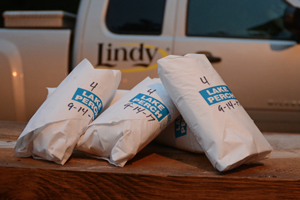 When we arrived at Bowen Lodge to launch the boat on Thursday, there was an obvious change in the traffic pattern. For the first time in a while, the parking area was full of rigs and the gas dock had a waiting line.
When we arrived at Bowen Lodge to launch the boat on Thursday, there was an obvious change in the traffic pattern. For the first time in a while, the parking area was full of rigs and the gas dock had a waiting line.
In light of recent reports about improving action on both Cutfoot Sioux and Lake Winnie, folks were anxious to get out and test the waters themselves. We were anxious too because we’d been hearing some good news about Perch fishing and that’s what we had planned for the day.
When we launched our boat, the air felt wet; there was a dense fog wrapped around us like soggy towel. The surface temperature had rebounded to 70 degrees and there was a fairly heavy algae bloom on the surface.
Because of the poor visibility, I along with everyone else chose to stay close to home while waiting for the fog to lift. That meant that the big lake Perch would have to wait and that we’d try for Walleyes on Cutfoot Sioux instead.
Cutfoot was somewhat crowded for the first couple of hours; there was still enough territory to fish comfortably, but it did dampen one’s ability to be creative. We worked our way around the boats and found a small stretch of open territory, marked some fish and claimed squatter’s rights.
The slow tapering shoreline point trailed out from a shallow weed bed and into deep water. There were fish on the breakline in 16 to 18 feet of water and Dick picked up one good keeper using a jig and minnow. A couple of repeat passes yielded nothing, so we moved to another point that also produced nothing. The fog was beginning to lift and we had perch on our minds so we considered the single Walleye a bonus and headed out to the big lake.
Locating Perch on the big lake was not an issue, there were lots of fish and they were very active. The locations we fished were shallow weeds located on large flats. Anyplace where we could find weeds in the 7 to 8 foot depth range produced fish. The only problem is that the vast majority of them were small and we had to catch as many as 10 fish before one of them would be a “keeper”.
Striving for our goal of 10 inch fish, we managed to bag 28 fish, but we did allow a few 9-3/4 inch fish into mix. There were a couple of fish over 11 inches too, but most of the fish we bagged were between 10 and 11 inches.
Admittedly an over-achiever by nature, I was somewhat frustrated by my inability to find more fish in the hard to find “plus sizes”. But when I got to the fish cleaning station, the fish looked nice, much better than I remembered them from the lake, so in retrospect I should have been a lot happier when we were catching them. After all, we did catch a couple hundred fish along the way and boredom was the least of our worries.
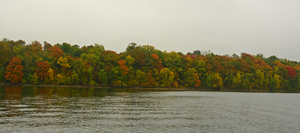 On Thursday, the Perch were definitely hungry and active; that’s one reason that we caught so many 6 to 9 inch fish. Under those circumstances, I should have had a better supply of larger size minnows. While I can’t promise that using 2XL size minnows will increase your catch of Jumbos, I can promise that large baits will help cut down on the incidence of attacks by little fish. If you’re not wasting your time reeling in a 6 inch fish, then your bait will linger longer, giving larger fish a chance to find it.
On Thursday, the Perch were definitely hungry and active; that’s one reason that we caught so many 6 to 9 inch fish. Under those circumstances, I should have had a better supply of larger size minnows. While I can’t promise that using 2XL size minnows will increase your catch of Jumbos, I can promise that large baits will help cut down on the incidence of attacks by little fish. If you’re not wasting your time reeling in a 6 inch fish, then your bait will linger longer, giving larger fish a chance to find it.
Along with a smattering of small pike, we did stumble into one large Walleye and one better than average pike. But for the most part, the shallow weeds were inhabited almost exclusively by Perch.
The best advice I can offer for anyone planning to pursue Perch this weekend is to bring plenty of large fatheads, golden shiners or other minnows in the 3 to 4 inch size range. Ignore the stories you hear about a destination for the “hot bite”, we found fish everywhere we stopped and the best size fish came from offbeat locations where there was no other boat traffic. Finally, keep moving around, the longer we stayed in one spot, the smaller the fish got. Moving around and locating small packs of larger fish was more productive in the long run.
Most other folks who fished on Cutfoot or Winnie yesterday caught some fish. Walleyes are more reliable on Cutfoot than they are on the big lake and so are Crappies. Don’t expect fast action though, the anglers who are reporting the best catches are fishing diligently. Keeping their noses to the grindstone and picking up their fish one by one.
Jig and minnow combinations are producing fish now, but so are spinners tipped with night crawlers. Ideal depth ranges are deeper than you may be accustomed to, fish are holding anywhere between 12 and 22 feet, with 16 to 18 feet being the most common range for fine tuning.
I'm not a big fan of changing weather, but at the same time, I do have to earn a living. So during the aftermath of last night's storms, I'll be at work, thankful for the opportunity to test my skills and hopeful that I can whittle down the choices and stumble into a decent bite. Whether I do or don't, you will be the first to know!
OH and by the way, if you're up for taking a boat ride this weekend, I think that the fall colors will be good. Wherever there are hardwood trees, especially Maple trees, the colors are changing fast. As you see in the photo, we spied some very nice strtches of shoreline on Thursday and they'll only be better this weekend.
 Jeff Sundin Fishing Report September 14, 2017 Fun with Dick & Paul & Mrs. Sundin - “Deciphering Mother’s Mixed Messages”
Jeff Sundin Fishing Report September 14, 2017 Fun with Dick & Paul & Mrs. Sundin - “Deciphering Mother’s Mixed Messages”
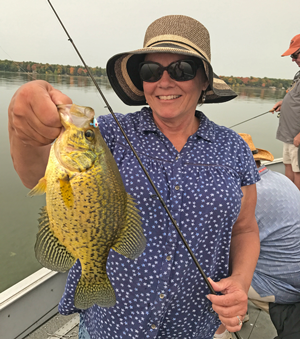 Joined by the lovely and gracious “Hippie Chick” AKA Susan Sundin, Dick and Paul tested the waters of Bowstring Lake with me on Wednesday.
Joined by the lovely and gracious “Hippie Chick” AKA Susan Sundin, Dick and Paul tested the waters of Bowstring Lake with me on Wednesday.
Hoping to find a mixed bag of Crappie, Perch, Walleye and Pike, we were somewhat surprised by the lopsidedness of the mixture. Crappies dominated our catch and it didn’t seem to matter whether we fished in shallow weeds, over rocky flats or on the deep edges of shoreline breaks.
I don’t mean to say that the specks were everywhere we went or that we didn’t have to work at finding them. We had to do all of the usual searching and probing to find a school of fish before we could wet a line. But it was odd that during the search, we never stumbled into a small school of Walleyes or Perch and it was especially strange that we didn’t pick up small Northern Pike along the way.
Strange too was the conflicting signals from Mother Nature. Looking at the shoreline we spied trees that were approaching full fall color. But the 72 degree surface water sported a thick green algae bloom, with insects hatching and small minnows lying just below the surface everywhere we went.
If you’re reading this report and fish for Crappies during the fall, then you’ll likely know just what to do and probably even know where to fish for them. It’s fair to say that all of the more popular presentations worked; here’s a brief recap.
We caught some of our fish trolling over the rocky flats using spinners tipped with medium size fatheads. Trolling speed was .9 to 1.1 MPH and we had to search for a half hour to locate school of fish before the action started. Once we found them though, the action was very good and as evidenced by a legitimate “quadruple” catch, it was even intense at times.
We caught other fish in deeper water and they were schooled up the way you’d expect to find Crappies during fall. The depth was about 16 feet and the fish were holding tight to some heavy rocks on one of the humps at the north end.
 The method we used, sometimes referred to as “tight-lining” is very effective, but admittedly, learning how to hold your bait at the proper depth does take some practice. This was a good day to be Paul because for some reason dialed in to the system best. He was using a 1/16 ounce Lindy Live Bait Jig tipped with a small fathead and his achievement was to discover the precise level at which to place his lure to entice the most strikes.
The method we used, sometimes referred to as “tight-lining” is very effective, but admittedly, learning how to hold your bait at the proper depth does take some practice. This was a good day to be Paul because for some reason dialed in to the system best. He was using a 1/16 ounce Lindy Live Bait Jig tipped with a small fathead and his achievement was to discover the precise level at which to place his lure to entice the most strikes.
The secret is holding the lure just above the school of fish, but still within range for coaxing them up to grab the bait. The idea is to make the fish move up to see your offering, once the fish move; they almost feel obligated to strike the bait. If you’re fishing too close to the bottom, most of suspended Crappies will not respond.
Speaking of responding, these fish responded to most everything we dropped in front of them, but the Live Bait Jig was best. I had a good run at them too using #6 Ice Worms tipped with an artificial tail and that lure also held its own very well.
Testing the shallow weeds for signs of life we discovered weed beds that were full of fish. Too numerous to keep track of, there were fish swirling, splashing, jumping and nipping at the surface. They were all feeding on small minnows that were holding tight to the tops of weeds that grew to the surface.
Despite the weeds teaming with fish of all shapes and sizes, it appeared that more Crappies, along with the aforementioned missing Pike were the only ones within reach for us to catch.
Normally I’d say that fishing in the weeds is one of my favorite ways to catch a mixed bag. But right now, the weeds are very thick and the water on Bowstring is very low. The combination of low water and dense weed growth makes it difficult to place a lure in position for a fish to find it.
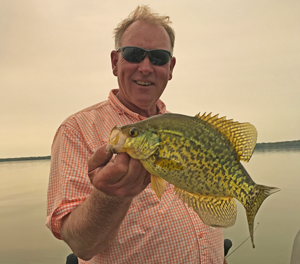 The one way that we were able to do it was to locate the areas where dense mats of weeds formed a wall that grew all the way out to a clean breakline. Casting jig and minnow combinations up to the outer edge of the weed wall and allowing them to fall to the bottom worked well enough to capture another 6 to 8 Crappies. Pike were fairly numerous too, but Perch and Walleye were nearly non-existent. In fact, we only caught one Walleye and two keeper Perch for the whole day.
The one way that we were able to do it was to locate the areas where dense mats of weeds formed a wall that grew all the way out to a clean breakline. Casting jig and minnow combinations up to the outer edge of the weed wall and allowing them to fall to the bottom worked well enough to capture another 6 to 8 Crappies. Pike were fairly numerous too, but Perch and Walleye were nearly non-existent. In fact, we only caught one Walleye and two keeper Perch for the whole day.
If Walleyes and Perch were not on the weedlines and they weren’t on the rock flats and we didn’t find ‘em on deep structure, then this only leaves us with two possible locations. Either they are holding on the lake’s expansive soft bottom flats, or they are further up in the weeds where we could not present a lure to them.
If they’re in the weeds, then we’ll see them on the breaklines as soon as the weather finally gets cold and forces all of the small fish and minnows into deeper water. If they’re on the flats, then we might see them and we might not, they may just stay out there until better feeding opportunities present themselves; I don’t know how to predict that.
So there you have it, if you’re thinking about Crappies, you’ll probably have some fun, and they definitely did their part to make our day fun.
With 3 days of fishing with Dick and Paul left, I’m hoping to position the boat over a good school of Perch. So for today, we’ll be exploring somewhere west of Deer River, where the batter Perch are said to be roaming; we’ll see.
OH! and by the way, thank you Dick and Paul for allowing our lovely stowaway to tag along!! ![]()
 Jeff Sundin Fishing Report September 13, 2017 "Fun With Dick & Paul Almost Fall"
Jeff Sundin Fishing Report September 13, 2017 "Fun With Dick & Paul Almost Fall"
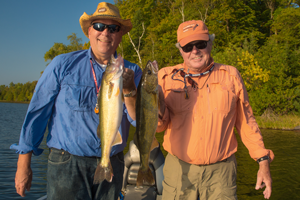 Murphy’s Law Corollary 523100; “Unexpected things happen unexpectedly.” Unfortunately, I know all about that one, but I’m also familiar with another, lesser known corollary and that’s 070510; “You wind up wherever supposed to, even if you didn’t plan it.”
Murphy’s Law Corollary 523100; “Unexpected things happen unexpectedly.” Unfortunately, I know all about that one, but I’m also familiar with another, lesser known corollary and that’s 070510; “You wind up wherever supposed to, even if you didn’t plan it.”
It sure is odd how coincidental equipment malfunctions can be; they always seem to happen when I have the same customers in tow. In fact, Dick Williams and Paul Kautza have watched me scratch my head about little breakdowns so often, that I spent my entire Monday fixing the fixable and maintaining the maintainable. I wanted to be sure that everything was up to code before we started the “Fun with Dick and Paul, Almost Fall” 2017 session.
Imagine my disappointment when I heard the low rumble of a wheel bearing gone bad as I pulled into their hotel parking lot.
The lake we decided to fish wasn’t even close to being part of my game plan. But knowing that we couldn’t drive very far before getting the rumbling bearing repaired, I selected the closest lake available, limped over to the landing and set the boat afloat.
Hopefully, we’d be able to catch a few fish while I worked out a repair plan for the trailer.
On our way out of the access bay, I recorded the surface temperature at 64.5 degrees and the shallow water was alive with aquatic life. The surface readings were within one degree of that benchmark and remained stable for the rest of our fishing trip.
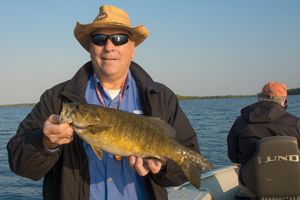 Walleyes are always one of our primary goals, but Dick and Paul like catching Bass, Perch and Panfish too. So with mixed bag fishing in mind, we rigged up with “Wiggle Worms” and started the mission on a weedy shoreline point.
Walleyes are always one of our primary goals, but Dick and Paul like catching Bass, Perch and Panfish too. So with mixed bag fishing in mind, we rigged up with “Wiggle Worms” and started the mission on a weedy shoreline point.
Within minutes, Paul landed a nice Smallmouth, then I missed a Walleye and then we got a Largemouth and then a small Pike. For the rest of the day, that’s how the fishing went. We caught a hodge-podge of fish, sometimes good ones and sometimes not so good, but we caught something at almost every stop.
The majority of fish were holding on and along the weed edges in water depths of 13 to 22 feet. Even though we spotted fish on the tips of points, the fish located on inside corners produced better action. It’s possible that the Walleyes that my Humminbird revealed on those open water points were just there to rest and therefore less interested in food than the fish that swam amidst the more competitive Bass and Pike. Or maybe the shadier weed edges simply represented better opportunity for feeding; they were loaded with small minnows, crawfish and even some insects hatching.
Someplace along the line, I spotted a school of fish that were holding higher above the weeds and appeared to be more engaged in feeding. Hoping to encourage that behavior, we set aside the jigging rods and set up some spinners instead. The first trolling pass yielded a nice Walleye, another Pike and a Bass or two. Subsequent trolling passes failed to produce many more fish on that weedline, but the spinners performed well enough so that we switched to that presentation for the rest of the afternoon.
Tipping the spinners with minnows worked, so did tipping them with night crawlers. I didn’t feel like there was an advantage with either of those two baits. The best trolling speed ranged between .9 and 1.0 MPH, a little slower than I’d fished this summer.
Walleye purists could be tempted to wrinkle their noses at our performance because we caught more Bass and Pike than we did Walleye. However, the tradeoff for us was that we captured 6 Walleyes of what I’d call supreme quality; 17 to 20 inches. Most of the Pike were small, but several were within the “eater” size range. The Bass were all over the map, ranging between 6 and 19 inches, but there were enough good ones to make catching them a fun experience.
![]() While that was all going on, Eric, Chris and Ryan from Ray’s Marine worked together to get my trailer bearings back into working order and by the time we wrapped our trip, my rig was ready for action again.
While that was all going on, Eric, Chris and Ryan from Ray’s Marine worked together to get my trailer bearings back into working order and by the time we wrapped our trip, my rig was ready for action again.
That makes this is a great time to mention that the folks at Ray’s have taken it upon themselves to sharpen their focus on having an outstanding service staff. I’ve had more than ample opportunity to test the results and based on my own experiences, they have bent over backward to ensure satisfaction.
Thank you for taking such good care of my rig so that I can take good care of my customers, I really appreciate it!
So there you have it, day 1 of Fun with Dick and Paul didn’t go as expected, but it went the way it was supposed to. I was prepared to drive a lot further, work a lot harder and maybe even return home with less. Instead, the forces of nature combined to put us on some good fish and be treated to some excellent repair service at the same time.
I can only hope that the next 4 days come close to that.
 Lake of the Woods, LOW Tourism September 12, 2017
Lake of the Woods, LOW Tourism September 12, 2017
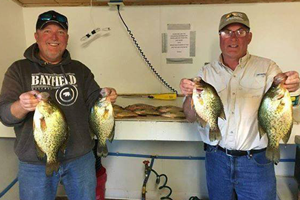 "As the water temperatures continue to drop, the walleyes have in turn put the feed bags on. Lots of shiners have made their way closer to shore and lighthouse gap for the spawn. Walleyes caught have full stomachs!
"As the water temperatures continue to drop, the walleyes have in turn put the feed bags on. Lots of shiners have made their way closer to shore and lighthouse gap for the spawn. Walleyes caught have full stomachs!
Crankbaits still producing, but spinners with crawlers or shiners and jigging with a shiner are also doing well. Big Traverse Bay continues to hold a good portion of the walleyes but reefs holding hungry fish and shorelines get better and better every day.
Anglers in the Rainy River finding some walleyes with morning & evening still the best. The river walleye fall bite hasn't quite hit yet but it could turn hot any day. Trolling cranks or pulling spinners producing the best.
Smallmouth bass in good numbers can be found along shoreline rock, bridge embankments and feeder streams. There are many sturgeons over 50" and 60" being boated at all times of the day and night.
Up at the Northwest Angle, in Minnesota waters, bottom bouncing, jigging, or trolling with cranks producing big numbers of walleyes. Current areas between the islands have been hot!
The best depths are deeper early and mid-day, sliding up to 10’ or less in the evening. Canada has been giving up more and more crappies every day, some at 16” plus.
Jigging with the lightest set up possible has been the most effective method; a few have even been caught on crankbaits, which continue to yield the nicest walleyes of the week with a few occasional Muskie. Jigging is also very productive for walleyes on 17-22’ shelves, on break lines with access to deeper water." – Lake of the Woods Tourism, (800) 382-FISH
 Jeff Sundin Fishing Report September 11, 2017 "Creeping Our Way Toward Fall Fishing"
Jeff Sundin Fishing Report September 11, 2017 "Creeping Our Way Toward Fall Fishing"
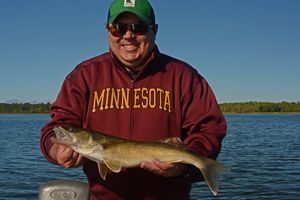 The past few days haven't felt much like fall and the warm weather isn't going away any time soon. But the early signs of change are evident and fish in Itasca area lakes are progressing, albeit slowly, toward fall feeding patterns.
The past few days haven't felt much like fall and the warm weather isn't going away any time soon. But the early signs of change are evident and fish in Itasca area lakes are progressing, albeit slowly, toward fall feeding patterns.
On Sunday, Surface water temperatures rebounded slightly, now hovering at about 65 degrees. That temperature is cool enough to encourage a change in fish behavior, but not cool enough to trigger mass movements into fall feeding areas. That means that presentations vary widely now and that anglers should be prepared to experiment with their choices of depth, structures and baits.
Over the past two days, we’ve spent lots of time fishing in Cutfoot and Little Cutfoot Sioux Lakes. The results have been favorable, but the action is definitely not at its peak. For us, there was a clear case of bad news vs good news.
The bad news is that Crappies have received very heavy fishing pressure and catching them is a much slower process than it was last week. We still caught some nice fish, but we worked harder and with more determination than before.
Patterns for both finding and catching Crappies are diverse too. We caught some fish in 25 feet of water by vertical jigging. We also caught some fish in the weeds by casting 1/16 ounce jigs tipped with artificial 2 inch action tails and we caught others by trolling over soft bottom flats using Little Joe Spinners tipped with medium fatheads. While we were doing all that, I observed some folks catching fish by anchoring and using slip floats to wait out small schools of moving fish.
 At the fish cleaning shack, everybody was cleaning at least some fish and as far as I could tell, anybody who wanted to catch Crappies did, even if they did not get full limits.
At the fish cleaning shack, everybody was cleaning at least some fish and as far as I could tell, anybody who wanted to catch Crappies did, even if they did not get full limits.
The good news is that Cutfoot is starting to cough up some Walleyes. A short Sunday afternoon session produced 4 ideal keepers, 15-1/2 to 17 inch fish for us. I know, that’s still a long way from wide open, but if you want to pick up a few for dinner, I think you can.
The best part of that fishing trip was that we caught those fish using jig and minnow combinations. I also know of a few other experienced fishermen who have made the switch to jig and minnow and they are picking up some fish too. The best part of this good news is that fall jig and minnow patterns are much simpler and more universally reliable than some of the patterns we’ve noted recently.
The turmoil of constantly changing presentations and having a dozen rods strewn around the boat takes its toll. That’s what we’ve needed to do to produce fish during these transition periods, so we’ve put up with it, however complicated it seems. That’s why I like the idea of showing up at the lake with one jigging rod, a scoop of healthy minnows and a stogie, this idea is very attractive.
Ironically, we spent the first 1/3 of the summer waiting for the water to warm up so that the fish would begin to strike. Now it appears that we could spend the last 1/3 of the season waiting for the water to cool down to make them strike. It is going to happen and it won’t take as long as we think, so I’m not going to wish away a single second of this nice weather. But when the next cold snap arrives, which I think should be the pivotal point that triggers the fall movement in earnest, we’ll have some fun on the lakes.
 Wired2Fish September 11, 2017 Compact Popticals Sunglasses Giveaway
Wired2Fish September 11, 2017 Compact Popticals Sunglasses Giveaway
 "If you are like us, sunglasses are hard to keep from getting scratched. Seems like they are always in the wrong place at the right time largely due to the fact they don't store well when not in use. Popticals has helped eliminate that with a unique design that packs small and compact. They also come with a custom hard case that fits into storage compartments and even your tackle box.
"If you are like us, sunglasses are hard to keep from getting scratched. Seems like they are always in the wrong place at the right time largely due to the fact they don't store well when not in use. Popticals has helped eliminate that with a unique design that packs small and compact. They also come with a custom hard case that fits into storage compartments and even your tackle box.
The beauty of Popticals is much deeper than storage however as they use nylon lenses crafted by lens gurus Carl Zeiss Vision. Super clear nylon lens rival glass but are much lighter and their clarity allows for better sight into the ..." Learn and Enter >> Popticals Sunglasses Giveaway
 Jeff Sundin Fishing Report September 10, 2017 "Now You See ‘Em, Now You Don’t"
Jeff Sundin Fishing Report September 10, 2017 "Now You See ‘Em, Now You Don’t"
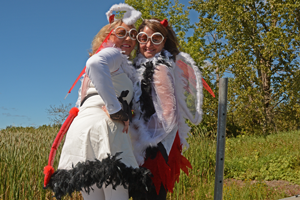 The Luscious Sisters and their entourage breezed into Bowen Lodge to enjoy a couple days away from the hubbub at work.
The Luscious Sisters and their entourage breezed into Bowen Lodge to enjoy a couple days away from the hubbub at work.
Revealing the much anticipated 2017 theme, “naughty and nice”, they allowed only their “nice” side to be observed by most of us. Unfortunately, there were a couple pails full of fish victimized by the duo, receiving an up close and personal look at their “naughty” side.
Crappie fishing was definitely the highlight of this year’s trip and in terms of production, made day #1 the best outing.
Forced out of the weeds by a cold front that had just passed through the Lake Winnie Region, there were numerous “fresh schools” of fish congregated in open water. For the time, the newly arrived fish were both eager to feed and easy to allure, making it easier than usual to capture bag limits for everybody in the party.
Typical of any early fall Crappie migration, water depth was not the primary factor in determining location. Virtually any open water area lying adjacent to a weedy flat represented a potential feeding area. We located fish in water depths of 8, 12, 15, 20, and 25 feet, so to catch them, we depended on an array of gizmos and gadgets.
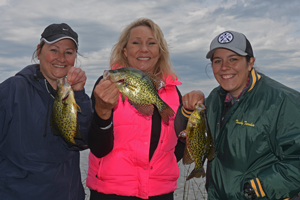 The deeper fish were more tightly congregated and the schools were larger, vertical jigging was the best presentation for them. While we caught fish on a variety of jigs tipped with live bait, the real secret weapon was the Ice Worm. Tipped with a small artificial tail, the compact ice lures were much more efficient because we didn’t have to spend time re-baiting after every strike. There may have been a “best” color, but I don’t know which one it was because everything we dropped into the schools of fish worked; it was just one of those times when the fish were eager to strike.
The deeper fish were more tightly congregated and the schools were larger, vertical jigging was the best presentation for them. While we caught fish on a variety of jigs tipped with live bait, the real secret weapon was the Ice Worm. Tipped with a small artificial tail, the compact ice lures were much more efficient because we didn’t have to spend time re-baiting after every strike. There may have been a “best” color, but I don’t know which one it was because everything we dropped into the schools of fish worked; it was just one of those times when the fish were eager to strike.
Later in the day, after most of the deep water fish had been heavily pursued, there was a slowdown. We moved shallower and began trolling with spinners looking for fish closer to the weed edges. It took some time, but eventually we started finding scattered schools of suspended fish. Some of them were close to the weed edges, but many of them were holding along the breakline between 12 and 16 feet of water.
Trolling speed was 1.0 to 1.2 MPH and we used 3/16 ounce bullet weights to get the spinners into position. Determining the correct line distance is critical to enticing strikes, the spinners need to come past the fish at, or just above eye level.
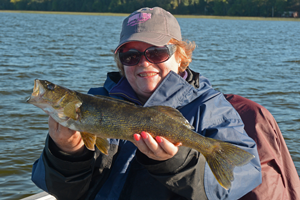 In our case, 30 to 35 feet of line was the magic number, but that can vary from day to day. Line weight, spinner sizes and even the type of minnow you use can all influence the trolling depth. If you’re fishing with a group, each of you should experiment with line distance until someone gets the precise formula. Once you think you have dialed it in, everybody should do their best to duplicate that same positioning.
In our case, 30 to 35 feet of line was the magic number, but that can vary from day to day. Line weight, spinner sizes and even the type of minnow you use can all influence the trolling depth. If you’re fishing with a group, each of you should experiment with line distance until someone gets the precise formula. Once you think you have dialed it in, everybody should do their best to duplicate that same positioning.
By day #2, Crappie fishing was not an option because the crew had their bags filled. The idea of trolling for a mixed bag of Walleye, Pike and Perch sounded good. In started off fairly well in the morning, but under sunny skies, the settled weather and rising surface temperatures encouraged fish to pull back into heavy vegetation. By midday, strikes had become few and far between, so we abandoned trolling and spent some time dabbling in the weeds.
Moving slowly across weedy flats, we dropped our jigs into pockets and small gaps between thick weed patches. Pike were the primary residents of the weeds on this trip, but there were some Perch mixed in and also a few Walleyes. I can’t say that we set the world on fire, but it was better action than we’d been having before; so it was good.
Back at camp, we ended the trip with a moonlight shore lunch and a warm camp fire. After telling a few stories and comparing the comparable, the 2017 Luscious Sisters “naughty and nice” adventure was officially logged into the archives.
 Wired2Fish September 10, 2017 Bank Fishing River Smallmouth Bass With Swimbaits
Wired2Fish September 10, 2017 Bank Fishing River Smallmouth Bass With Swimbaits
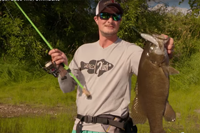 Swimbaits are often fished on jigheads or weighted worm hooks as a deeper presentation but W2F staff McKeon Roberts shares why he chooses to rig swimbait style plastics texposed and weightless around current. The broad body of the plastic catches the current and its natural bouancy paired with only a 3/0 worm hook allows it to act much like a natural dead or dying baitfish would. Bass sit and wait in areas of current where potential food items are pushed to ..." View Video >> Bank Fishing River Smallmouth Bass With Swimbaits
Swimbaits are often fished on jigheads or weighted worm hooks as a deeper presentation but W2F staff McKeon Roberts shares why he chooses to rig swimbait style plastics texposed and weightless around current. The broad body of the plastic catches the current and its natural bouancy paired with only a 3/0 worm hook allows it to act much like a natural dead or dying baitfish would. Bass sit and wait in areas of current where potential food items are pushed to ..." View Video >> Bank Fishing River Smallmouth Bass With Swimbaits
 Jeff Sundin Fishing Report September 6, 2017 "Cold Front Ushers In “Crappie Day” For Fishing"
Jeff Sundin Fishing Report September 6, 2017 "Cold Front Ushers In “Crappie Day” For Fishing"
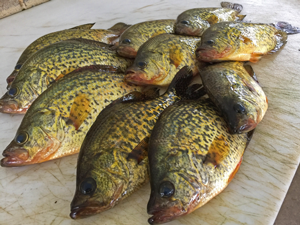 Surface temperatures plunged into the mid 60 degree range on Tuesday. In the aftermath of Labor Day storms, the cold front pushed into the Itasca Region, bringing along strong northwest winds and slate grey skies.
Surface temperatures plunged into the mid 60 degree range on Tuesday. In the aftermath of Labor Day storms, the cold front pushed into the Itasca Region, bringing along strong northwest winds and slate grey skies.
The affect that the wind chill had on fish is uncertain, but the cold wind did not help my crew warm up to cold weather, fall fishing or numb fingers.
Every year somebody has to be the first one to hear me say; “The cold snap will be good for fishing in the long run. It will spur baitfish movements, kill off shallow water weeds and trigger fall feeding binges. But first, we’ll have to live through the transition between summer and fall.”
Peruse the archived fishing reports and you’ll see that most years, it is Dr. Crappie who writes the prescription for providing relief from the agony of transition time. When the weather changes and conditions get tough, Crappies are first in line to provide anglers with a reason to smile during early fall.
On Tuesday, America’s 2nd most popular gamefish proved that there was still a reason to fish, even if our fingers were cold.
Some Crappies have moved toward their fall haunts, but the water is still 64 degrees and that’s not cold enough to make the entire population of fish shift away from shallow weeds where they spent most of their summer. At least that’s the scenario we found on Tuesday when most of the fish we caught came from cabbage patches located in 5 to 7 feet of water.
In the Cabbage, fish were scattered, but they were active and whenever we encountered them, they struck aggressively. The trick was to keep moving, picking up the most active fish as we entered their strike zone.
At first, Live Bait Jigs tipped with minnows was our preferred presentation, but the strong wind drifted us so fast that it was much easier to troll with spinners. Luckily, it didn’t matter whether we used jigs or spinners, the fish were equally eager to take either bait and that locked us into the trolling pattern for the morning.
I think we could have stayed in the shallow weeds all day long, but as lunchtime approached, a warm up sounded good. But before we left the lake, I stopped in one traditional fall spot located in deeper water. There we found another school of fish and they were catchable too. The problem was the wind, trying to finesse Crappies out of deep water in 2 foot waves isn’t the easiest way to catch them. So while the experiment paid off in terms of knowledge, it was a lot more fun to fish the weeds in calmer water.
With plenty of Crappies to satisfy my crew, we turned our attention toward Perch fishing. At first, it seemed like we’d catch plenty of those too, but for some reason, the action stopped as fast as it started. So for a couple of hours, we scrounged around the weeds picking away at a mixed bag of small pike and perch. It was easier to cope with the cold wind while we were catching big black crappies. But catching little green perch and snaky pike was not as much fun; the cold wind soon won the battle and sent us packing for the cabin.
Today promises to deliver a new challenge, the winds have passed and apparently we’ll be testing our skills on calm water, under sunny skies; this will be interesting.
 Lake of the Woods, LOW Tourism September 6, 2017
Lake of the Woods, LOW Tourism September 6, 2017
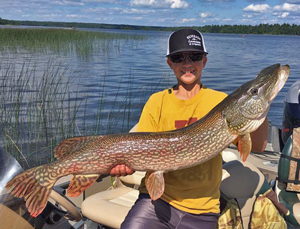 "Fall temperatures are here and excellent fall fishing has come with it. Good numbers of walleyes moving closer to shorelines. Walleyes in front of Lighthouse Gap increasing. Crankbaits and spinners with crawlers or shiners doing the best. Big schools of walleyes in no man's land of Big Traverse Bay. Reefs producing well! Hammered gold, glow, perch, crayfish all good colors.
"Fall temperatures are here and excellent fall fishing has come with it. Good numbers of walleyes moving closer to shorelines. Walleyes in front of Lighthouse Gap increasing. Crankbaits and spinners with crawlers or shiners doing the best. Big schools of walleyes in no man's land of Big Traverse Bay. Reefs producing well! Hammered gold, glow, perch, crayfish all good colors.
Anglers in the Rainy River finding some walleyes with morning/evening still the best. Some shiners starting push back up the river with hungry walleyes on pursuit. Trolling cranks or pulling spinners producing the best. Smallmouth bass in good numbers along shoreline rock, bridge embankments and feeder streams. Sturgeon anglers finding great success while moving around until you find the right hole. Many sturgeon over 50" and 60" being boated.
Up at the Northwest Angle, in Minnesota waters, mixed bag of walleye/perch limits. Fish are being found in many areas; shallow 14-18’ and deeper 25-28’. While fish are spread out, bottom bouncing continues to be a popular and effective approach.
In Canadian waters, crankbaits have been producing larger walleyes, while bottom bouncing and jigging the deeper waters between reefs is yielding fish as well. Crappie season is in full swing with fish in 30 ft plus off of points with a jig and minnow. Muskie action continues. Anglers experiencing multiple fish days and seeing big fish move on a variety of baits such as blades, top water or minnow baits. With the approaching full moon, it should only get better." – Lake of the Woods Tourism, (800) 382-FISH
![]() Lake of the Woods, Border View Lodge September 6, 2017
Lake of the Woods, Border View Lodge September 6, 2017
"Here comes Fall! One of the best times of year with more great fishing ahead! Hunting activities are starting and temps are dropping. It is time to get excited about another Shiner Minnow run in the Rainy River. The gear is in the water and ready to go.
We have continued to fish in Big and Little Traverse Bay’s with a mix of drifting with spinners or pulling plugs. Depending on the winds there have been days when there was no need for the long boat ride North. There has been great action for the week and many nice keepers and big Walleye released. We continue to see the number of fish outside the Lighthouse gap increase.
The forecast for the week ahead shows typical weather for September, Highs mostly in the 60’s with cooler overnight temps which may get in the 30’s.
Our winter rates are published on our website, book early to get the best dates. Here is a great deal on Sleeper Houses for this coming winter. Make your Sleeper House reservation for a Mid-week stay by November 30th and get 10% off." - 1-800-776-3474 Border View Lodge .
 Jeff Sundin Fishing Report September 5, 2017 "Wiggling Our Way Into Fall"
Jeff Sundin Fishing Report September 5, 2017 "Wiggling Our Way Into Fall"
Labor Day Weekend has come and gone after dishing out its fair share of surprises for anglers who visited the Itasca Region.
Probably the most pleasant surprise and surely the highlight of my weekend occurred on Saturday, when we fished for Walleyes on a very non-traditional lake.
 The small lake, known primarily as a Bass fishery, has just enough Walleye to provide an occasional catch of good size eaters, but not enough to be considered a destination for Walleye anglers. For me, occasional means that I visit the lake one time each season and usually no more; unless I get skunked the first time and go back for a re-match.
The small lake, known primarily as a Bass fishery, has just enough Walleye to provide an occasional catch of good size eaters, but not enough to be considered a destination for Walleye anglers. For me, occasional means that I visit the lake one time each season and usually no more; unless I get skunked the first time and go back for a re-match.
After you’ve had a good fishing day on a lake, it’s awfully tempting to go back and do it again. But I believe lakes like this one can only provide good fishing as long angling pressure remains low. Any sophisticated angler could easily wreck their own honey hole by making too many visits. I’d rather count on one good fishing trip every year than to fish the daylights out of it now and then have to wait 5 years for its recovery.
There’s are dozens of lakes like this scattered around the region though and I think if you do some research, you can turn up a handful of your own little gems like this one.
What’s interesting to me is how often the Walleyes that live in these non-traditional lakes have homes on very traditional walleye structures. It’s not uncommon for lakes to have just a few spots that Walleyes will routinely inhabit and they’re usually not hard to identify.
In this case, a simple shoreline point lying adjacent to a weedy flat provides the entire habitat that the small school of Walleyes needs to live. They simple move between the weeds and open water, taking advantage of whichever feeding opportunity suits them best during any portion of the season.
With declining water temperatures, slower moving presentations are coming back into vogue.
Wiggle Worming worked well for us on Saturday and turned out to be the most productive presentation of the entire weekend. In fact before our trip was cut short on Monday, Wiggle Worming was heading us in the direction of another very respectable performance.
Not unlike the tiny lake we fished on Friday, walleyes in the much larger, 6500 acre lake were living on a shoreline point too. And like their small water cousins, 22 to 24 feet of water was the magic number on Monday too.
 It’s not too often that I get really hung up on a color for this presentation. I think that the night crawler always does the lion’s share of the work. But it was hard not to notice that in the highly trained hands of Annalee Jones, the Pink Lindy Live Bait Jig was outperforming all of the other colors combined.
It’s not too often that I get really hung up on a color for this presentation. I think that the night crawler always does the lion’s share of the work. But it was hard not to notice that in the highly trained hands of Annalee Jones, the Pink Lindy Live Bait Jig was outperforming all of the other colors combined.
This isn’t the first time that Pink has been singled out as a special color in these reports and it’s not the first time that it’s happened during the fall season. Maybe there’s a correlation between fall feeding patterns and the color Pink, or maybe it’s just coincidence. Either way, by the time the thunderstorms cut our trip short, Annalee and her Pink Live Bait Jig had produced 75% of the Walleyes that we bagged.
Sandwiched between the two happy days was Sunday, a day that will be forgotten as soon as possible. Not because it wasn’t a gorgeous day, it was. In fact it was so gorgeous and there were so many people on the lake that it made fishing very difficult. Between the waves caused by folks engaged in the most recent craze, wakeboarding and the fact that every good fishing spot was previously occupied, my day was a real head-scratcher!
That’s okay, with Labor Day in the rearview mirror, the lakes will settle down and soon, fall fishing patterns will take hold.
With the passing of yesterday’s storms, we’re looking forward to one of those aftermath days. A cold front, combined with strong northwest winds will force me to be creative on an outing that focuses on Crappies and Perch. Many of the lakes that offer this particular combo are large, maybe too large for my crew.
We’ll see though, maybe the full moon will add a helpful dimension, maybe the weather will be better than expected or maybe I’ll just get lucky!
"Lund Boat For Sale; Help Jeff Sell The Boat and Receive Free Fishing Trip" Jeff Sundin
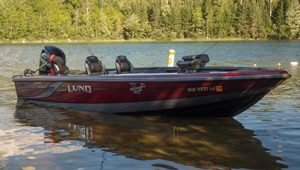 "Lund Boat, 2016 208 Pro V GL Tiller, 2016 Mercury Verado 200 HP “Big Tiller”, Lund 2016 Dual Axle Bunk Trailer.
"Lund Boat, 2016 208 Pro V GL Tiller, 2016 Mercury Verado 200 HP “Big Tiller”, Lund 2016 Dual Axle Bunk Trailer.
You've been ready for the ultimate ride in a tiller boat for a long time, but you thought it would be way too expensive for you; not anymore! It's time for me to make room for a new rig and that means that you can cash in on big savings by picking up this rigged, ready and fully trained in luxurious fishing boat.
If you’re reading this page, then you already know that I like to keep things simple and it was true when I set up this boat, my setup is for maxium efficiency as a tiller rig. It is simple but effective, leaving you a platform with plenty of space to add your own ..." Learn More >> Lund Boat For Sale
 Comprehensive Underwater Side Imaging Video Teaches Everything! Top Rated Video!
Comprehensive Underwater Side Imaging Video Teaches Everything! Top Rated Video!
Okay lets cut to the chase. If you've ever asked a question about using side imaging, how it works or why it works; then you need to watch this video. This is the most comprehensive turorial about using side imaging technology that I've ever seen.
Wired2Fish teamed up with Jeff “Kolo” Kolodzinski of Humminbird to create this detailed video about understanding how and why this technology works.
"The featured product is Humminbird’s Helix-12, but the concepts will help you regardless fish finder manufacturer. Kolo breaks down how to read and interpret what side imaging, down imaging, and two-dimensional (2D) sonar are showing you, and how they can improve your fishing. We filmed real-time drone and underwater video of screen readouts to show you what rocks, weeds, fish, and bottom hardness changes look like on the screen, from the air, and below the water - seeing is believing." View Video >> Understanding Side Imaging Technologies
 Jeff Sundin Fishing Report September 1, 2017 "Settling At Seventy"
Jeff Sundin Fishing Report September 1, 2017 "Settling At Seventy"
Surface temperatures have settled on the shy side of 70 degrees as a resting spot for the Labor Day weekend. Obviously, temps will vary depending on the lake you fish, but fishing patterns will be similar throughout the Itasca Region.
Knowing that my work assignment on Thursday would be to target Walleye, I rigged up fishing rods for both shallow and deep water spinners.
I’d be returning to one of the lakes that provided great action a few weeks back, when water temperatures were at their summer peak. My hope was that the water was warm still enough to encourage using the fast moving, trolling presentations that worked so well. This would allow me to cover water quickly to establish location and then hopefully, I could zero in on a precision presentation which would be more Walleye selective.
After making a couple of stops that didn’t pay off, my faith in the pattern was rewarded. Our first fish was a 23 inch slot-fish, followed by two more 19 inch slot-fish that were returned to the water. That was a great start and it appeared that we’d be in tall clover for the rest of the day. Long story short, we were in clover all day long, but it was short, not tall.
Catching and releasing 13 inch Walleyes was easy, I guess we boated a couple of dozen, maybe more. The problem was that both the mid-size keeper Walleyes and larger slot-fish were extremely rare. In fact we left the lake at 5:30 PM with only one fish in our creel, a 16 inch Walleye that grabbled the wrong Little Joe spinner at the wrong time.
The segregated populations of fish were a surprise to me; the anticipated mixed bag did not occur.
All of the Walleyes we caught came from mid lake structure and all of them were caught on spinners tipped with night crawlers. We used 1-1/2 ounce bottom bouncers to control our depth and held trolling speed to about 1.2 MPH.
Spinning the weeds, using Little Joe spinners behind a 3/16 ounce bullet sinker was a pattern that also worked well for Walleye few weeks ago. But this time, while it did produce plenty of Northern Pike, we did not boat any Walleye in shallow water.
If the goal had been to produce lots of fish for eating, Pike would have gotten the nod. They were mainly small, but there were what could have been eaters, along with one big fish that threw the bait before we could land it for a measurement.
Perch offered little in the way of action, but the ones we caught were nice ones. We didn’t bother trying to perfect a suitable presentation for them, but if needed, I think they could have provided good protein too.
For many, this would have been a disappointing report, but for us it wasn’t. My kind and gracious crew reminded me; "The goal really wasn’t to bag a lot of fish, it was to catch them."
For that I say thank you, it's really gratifying to fish with folks who appreciate the sport of fishing in the broader sense. I don't know many anglers who don't like to eat fish; I do too. But the most lasting memories about fishing come from somewhere deeper, someplace emotional. Trees changing color, Eagles in flight, the big one that got away; these are the subject of campfire conversation.
I think it’s rare to discover anybody with an emotional attachment to the harvest of fish meat.
Admittedly, I had hoped that we’d catch and release a greater number of larger size fish, but Walleyes don’t always play fair. We did have some un-realized opportunity, soemtimes larger fish stuck without finding the hook. I gues that they were present, but not feeding as actively. So today, the action compensated for quality and if nothing else, provided a learning experience to apply on the next outing.
For today, I’m heading for the lake that contains the widest range of fish species that I know of. Action is on the agenda and Walleyes are the least of my concerns. Crappie, Sunfish, Perch, Rock Bass, Pike; they are all fair game. If Mr. Walleye gets in the way, that’s his problem.
I’ll be out on the water this weekend, but like many, I plan to relax a little too. So there may be a greater emphasis on fun and less focus on production. If you’re on your way to the lake this weekend, I hope you have a fabulous trip.
Home | Current Fishing Report | Saved Fishing Reports | Favorite Lakes | Fishing Articles Section | Recipes | Rates Services | Gift Certificates | Contact | For Sale | Links | Sitemap |
"The Early Bird Fishing Guide" Jeff Sundin - Fishing Blue Books, LLC 715 Byington Ave, LaPrairie, MN 55744 218-245-9858
Email copyright©2017 Fishing Blue Books, LLC All Rights Reserved - last revised 11-01-17